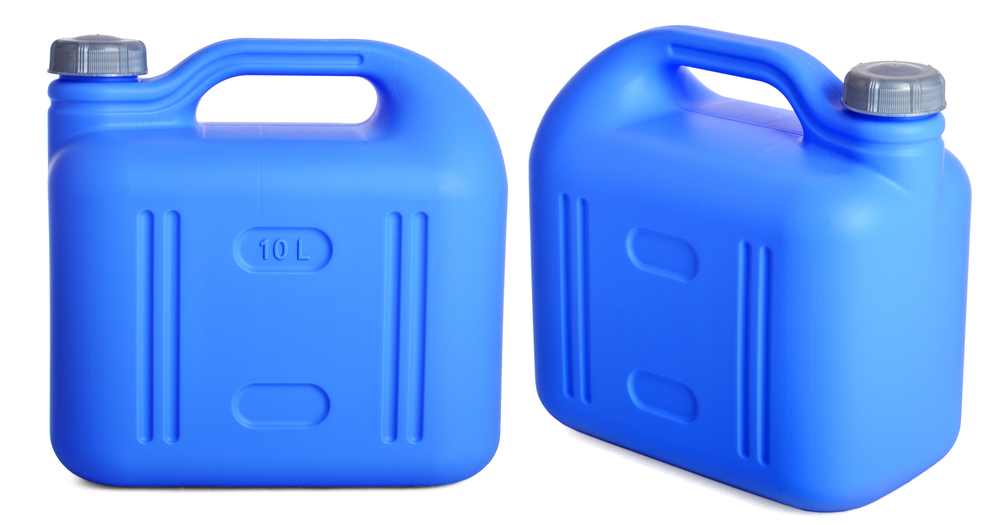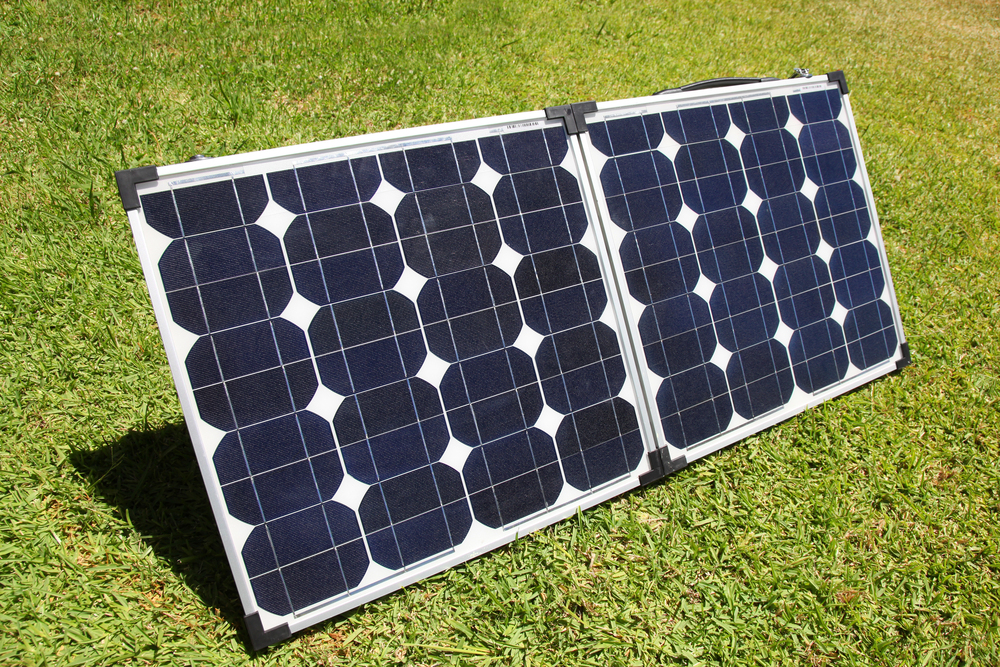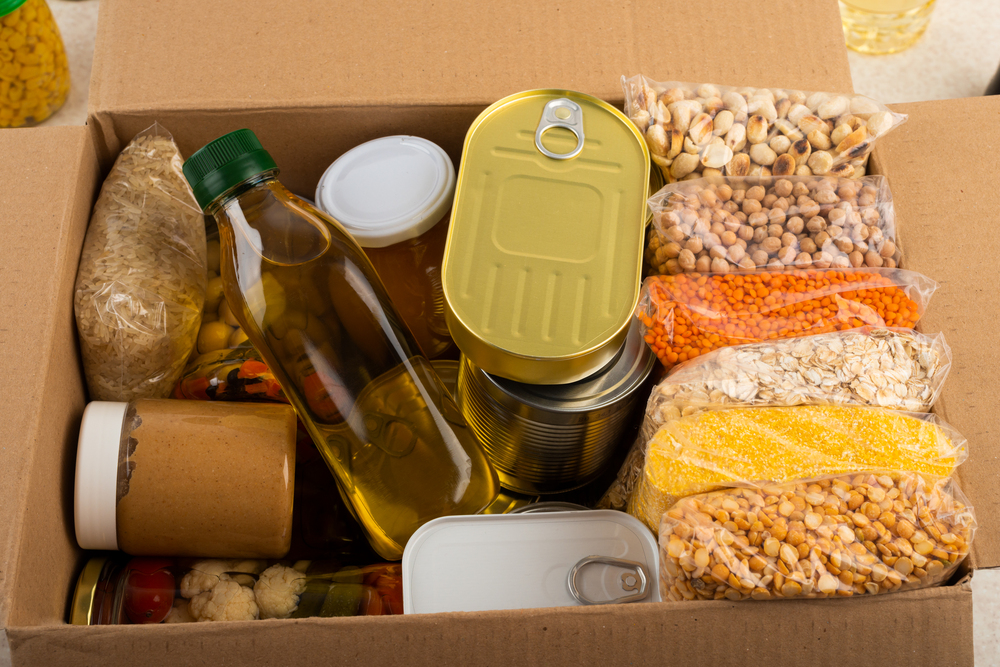If you’re new to the prepper journey, getting started with prepping can feel overwhelming. And prepping with kids adds a layer of complexity. That’s why you’ll want to start teach your kids prepping skills now, while you’re building up your supplies.
There are so many skills to learn, so many supplies to buy, and what even are we prepping for?
I also felt overwhelmed I first started prepping. We were living in Florida at the time. That was the year Florida was hit by several hurricanes in a row, and every single time, people mobbed every local store in the days leading up to the storm. Bottled water, flashlights, candles, matches, batteries, radios, sandbags, hammers and nails and plywood – you couldn’t find them for love or money. So yeah, I’d failed prepping 101 because I hadn’t stocked up way beforehand – before everybody else did.
It also felt very unsafe to be shopping at the time. People were angry and frightened, which meant that they were getting aggressive when everyone started trying to grab up the last supplies on the shelf at the same time.
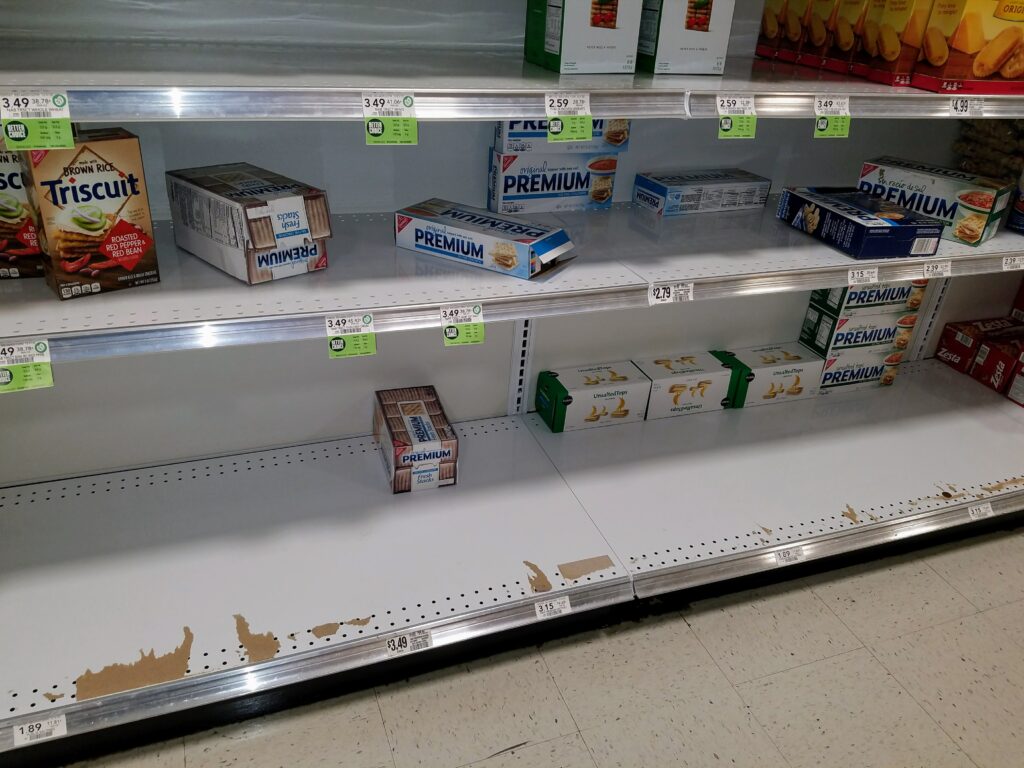
The price of essentials suddenly shot up. A lot of gas stations began raising their prices illegally, too. It was frustrating and infuriating. I never wanted to find myself in that position again.
What I did at the time – I filled up the bathtub and sinks with water, along with every vessel I could find in the house – cups, bowls, pots and pans, even glass vases, et cetera, because I needed water for both my family and my pets. I went on a cleaning and organizing spree, and found a bunch of candles that were scattered around the house.
I also went to the pharmacy and paid out of pocket for extra medicine for a child of mine that needed it.
I also went on the internet, while we still had power, and learned how to make a lamp with a jar, a bottle cap, a screwdriver, cooking oil, and cotton string. My children were highly entertained – kids love to make things – and that was when I realized that I could involve them in my prepping journey, and make it fun and not scary.
Once the hurricanes had passed, I started studying and at first I was overwhelmed with how much stuff I would need to buy and learn. Also, at the time, I lived in the city and I didn’t have the option to start a garden large enough to support my family, to get chickens, etc.
So I had two choices: give up, or adapt to my circumstances.
I realized I had to address prepping the same way I do spring cleaning or any other big, complicated job: break it down into small, manageable steps. Do what I can with the resources I have on hand, and think about the old joke, “How do you eat an elephant? One bite at a time.”
First Steps For Prepping
1.) Do not tell everyone that you are prepping. Seriously. It’s called op-sec (operational security). If things ever take a bad turn for months, or years, or forever – you do not want to advertise to anyone that you are the house with a large supply of food, batteries, and weapons. Starving people get very desperate. If there is a breakdown in law and order, you do not want to make yourself a target.
If you think your kids are not going to be capable of keeping it a secret – and younger kids generally aren’t – then be careful what you share with them about your stash of supplies. You do want them to be prepared for any disaster, but you can prepare your kids for disaster by teaching them basic survival skills like gardening, canning and preserving, safely building a fire, basic first aid, etc. without telling them that you are storing up lots of food and ammo.
Once they get old enough that you can trust them not to tell, then you can show them what you have stored, and where, in case there’s ever an emergency where they’re on their own at home and need to access supplies.
If you find a local prepper group, or if you have like minded neighbors and you trust them implicitly, that’s a different story.
My family has a good network with our local church, yet another reason why it’s a good idea to go to church (just had to get that in there.)
Also, for extended family, or close friends – maybe you have a very good location, and therefore you end up being the place that everyone bugs out to. That’s fine, but if I were you, I still wouldn’t tell them that they have a large amount of food and ammo stashed. Word tends to get around.
2.) Decide what you are prepping for.
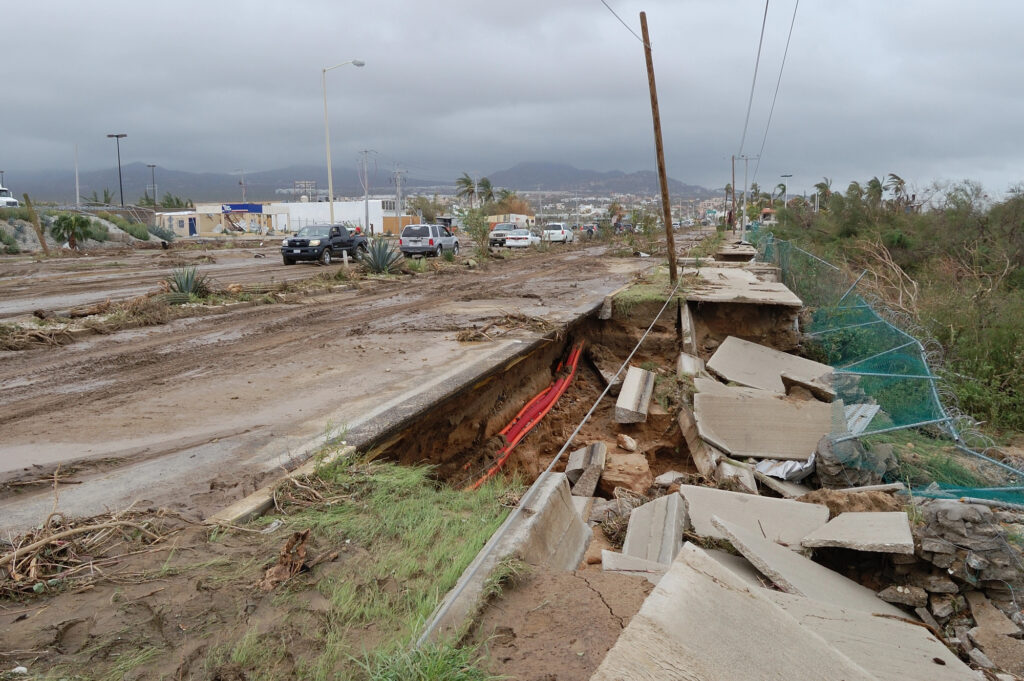
What disaster do you think is most likely to occur? There’s no right or wrong answer. Decide what you want to prep for, so you can figure out what types of supplies and training you will need.
If you visit prepper groups online, you will always come across people posting vague hints that they are more in the know than everyone else, and everyone better get their final preps down because it’s going to be TEOTWAWKI some time within the next few days/weeks/months. (TEOTWAWKI is a common prepper slang term for The End Of The World As We Know It.)
Well, I call bull-shitaake, because I’ve been reading those same vague online warnings for more than a decade, and none of them have been right. Remember how the world ended, as predicted, in 2012? Nope, me either. Remember earlier, when all computers all over the world crashed, and communication systems went down, as predicted, as midnight of the year 2000 hit?
Nope, that one didn’t happen either.
Note – I am not saying there is NOT a big disaster coming, I’m saying that most of us are not going to be privy to what the specific disaster is, before it comes. Don’t make plans based on vague rumors.
What Are Preppers Prepping For?
- Hurricanes
- Floods
- Tornadoes
- Earthquakes
- EMP (A weapon that blasts and fries all electronics for a wide area)
- Terrorist attack on the grid
- Terrorist bombings
- Grid just fails in large parts of the country
- Nuclear war
- Civil war
- Economic collapse
- Personal economic problems
- Pandemic
- Coronal Mass Ejection which could take large parts of the grid down
- Volcano eruption, such as the Yellowstone Supervolcano
- A change in regime to an extremely oppressive government – yes, worse than what we currently have.
These are the main things that I think are most likely to happen. Then there’s always the possibility of an asteroid or some other such off the wall event, but anyway, moving on…
Prepping First Steps
So, for Prepping 101, what are the first steps that you should take? Most of us don’t have a huge amount of money to run out and sink a fortune into buying a remote piece of property and turning it into a prepper heaven and stocking it with a decade’s worth of supplies.
You’ll want to prepare for two possibilities. Bugging in, or bugging out.
Bugging in: Start by building up enough non-perishable (doesn’t need to be refrigerated) food and water to survive for at least 30 days without going shopping. This is more than enough to cover most disasters that any of us have faced in our lifetime, which can include power outages that take a few weeks to restore, and roads cut off by floods or debris.
Make a list of every family member, and plan for three meals a day per person. This has to be non-perishable food that you can eat if there’s no refrigeration. You also need a way to boil water to prepare dehydrated food, and little cook-stoves can be great for that. You can also buy MREs which do not require cooking.
Don’t forget about things like salt, pepper, coffee, tea, canned or powdered milk for your drinks, sugar, cooking oil, and spices and seasonings. Dehydrated meals and MREs can taste pretty bland.
If things get tight you might have to cut down to two meals a day, but it’s hard to function and defend yourself and your home and family when you’re hangry. Let’s say you have a family of four. 3 times four is 12 meals a day, times 30 days is 360 meals for a month.
As for water, it is recommended that you have approximately a gallon a day for drinking water. That’s a bare minimum of 120 gallons of drinking water for thirty days, for four people. That does not include water for flushing the toilet, brushing teeth, or daily toileting activities. While FEMA recommends that people keep on hand one gallon per day per person, I would recommend doubling it so you can brush your teeth, wash your face, etc. If you need water for re-hydrating food, consider tripling it.
It will also help to buy sanitary wipes to cut down on the amount of water you’d need for washing.
If you’re bugging in, it’s worth investing in some stackable water storage and a waterbob which you put in your bathtub and fill with water, before you lose power. If you have advance warning that you’re going to lose power, like say a major hurricane is coming, you’d want to fill every jar and bottle and vessel that can contain water in your house with water before the power goes out.
Prepper tip for water: you can use the water in the toilet tank if you get absolute desperate. Boil and disinfect first. You’re using the water in the TANK, not the toilet boil.
Medicine
Never get down to your last week of medicine. Get at least an extra month’s supply of medicine for anyone in your household who needs it. Pay out of pocket if you have to.
Does any of your medicine need to stay refrigerated? Is anyone in your household oxygen dependent or do they depend on medical equipment to survive? In that case, do whatever you can to get a small generator that will run a small fridge for the medicine, and/or power your medical equipment. I don’t like taking on debt, but if it were a matter of life and death, I’d take out a loan to get a generator if it would keep someone in my house alive in a power outage. Make sure to get any generators professionally installed and follow all safety instructions. Make sure you have enough fuel to run the generator for at least several weeks.
Don’t Forget Your Pets
People come first, of course, but make sure that you have at least a month’s worth of food and water for any pets that you have too. Observe how much water they drink per day so you can get an accurate amount for how much you’ll need to store.
4.) Building your Bug Out Bags
Bugging out – having to abandon your home for any reason – is a last-choice option, but if there’s a forest fire, civil war, hurricane, flood, etc. heading your way, you may have no choice.
Each person in your family should have a bug-out bag. Here are some of the items you’d want to consider including in that bug-out bag:
- Water: At least 3 liters per day per person, in bottles or a hydration bladder.
- Water filtration devices like a Lifestraw.
- Food: Non-perishable items like energy bars, dried fruits, nuts, and canned goods.
- Multi-tool: Versatile tool for various tasks like cutting, opening, and repairing.
- First Aid Kit: Including bandages, antiseptic wipes, pain relievers, and any personal medications.
- Emergency Shelter: Lightweight tent, tarp, or emergency blanket for protection from the elements.
- Fire Starter Kit: Waterproof matches, lighters, and/or fire starters for warmth and cooking. Keep these in a ziplock bag.
- Clothing: Extra layers, including socks, underwear, and a waterproof jacket.
- Flashlight or Headlamp: With extra batteries or a solar charger.
- Navigation Tools: Map, compass, and/or GPS device.
- Hygiene Supplies: Toilet paper, wet wipes, hand sanitizer, and menstrual products if needed.
- Personal Documents: Copies of identification, insurance papers, and emergency contacts.
- Cash: Small bills and coins for purchasing essentials if electronic payment isn’t possible.
- Knife or Fixed Blade: For self-defense, utility, and bushcraft tasks.
- Paracord or Rope: Versatile for building shelters, securing gear, and other tasks.
- Water Filtration or Purification: Portable filter or purification tablets for obtaining safe drinking water.
- Emergency Radio: Hand-cranked or solar-powered for receiving emergency broadcasts.
- Duct Tape: Useful for repairs, patching, and improvising gear.
- Whistle: For signaling for help in case of emergencies.
- Gloves: Sturdy gloves for protection and work tasks.
- Spare Batteries: For any electronic devices you’re carrying.
- Notepad and Pen: For taking notes, leaving messages, or journaling.
- Sunglasses and Sunscreen: Protection from UV rays.
- Emergency Blanket: Reflective material for warmth or signaling.
- Respirator or Dust Mask: Protection from airborne contaminants.
- Personal Defense Items: Pepper spray, firearm (if legally and responsibly carried), or other defensive tools.
- Sewing Kit: Needles, thread, and patches for repairing clothing and gear.
- Entertainment: Deck of cards, book, or other small items for passing time and boosting morale.
- Signal Mirror: For signaling rescuers if lost or in distress.
- Compass: For navigation if GPS is unavailable or unreliable.
- Cell phone battery pack, and extra chargers and cords, in case cell phones service is still available.
Don’t forget to pack a bug-out bag for any of your kids who are old enough to walk.
Car Emergency Kit/Get Home Bag
In my car emergency kit, I keep things like towels, tarp, rope, a first aid kit (but not medications because they will be effected by temperature), hand-warming packs, a couple of thermoses, extra socks, waterproof matches, sleeping bag, and, depending on the weather, can opener, a box of granola bars, as well as jumper cables and tools, and a couple of paperback books in case I’m stranded somewhere for a long time.
When I get in the car to go somewhere, I bring a separate bag with flashlight, batteries, and food, and if I needed medication I’d pack that too. Then I bring that bag back into the house with me when I get home. I don’t want to fill my car emergency kit with items that will get ruined by freezing or overheating when the weather gets extreme.
A Get Home Bag is something that you bring with you to the office. It’s different than a bug-out-bag in that it’s meant to have enough supplies to get you home safely if an emergency happens, and either roads are blocked or cars aren’t working due to an EMP, and you have to walk 20 or 30 or more miles to get back to your house. A bug out bag should have more supplies in it because it’s designed to sustain you if you have to leave your home and can’t return for weeks or possibly ever.
For a get home bag you’d only need a few days worth of supplies. Map, compass, food, canteen filled with water, a water filtration straw if your water runs out and you have to drink from puddles, spare socks, small tarp and rope, small first aid-kit, moleskine for blisters, a battery pack for your cell phone if cell phones are still working, a multi-tool, small hand-cranked radio…this can be sufficient for a get-home bag.
Physical Fitness For Preppers
Now is the time to get your family into hiking and camping. You do not want to wait until the zombies are approaching to realize that you’ve all got well-stocked Bug Out Bags…and you don’t have the physical stamina to carry them more than a quarter-mile from your house.
So take that well-stocked bug out bag, and go for a walk in your neighborhood, and see how far you can get without getting out of breath. There’s no shame in it if you only make it a few blocks before you’re wheezing like a wounded whale, but that tells you that you – and most likely your family – need to start making cardio a regular part of your life.
Again, we all hope we’ll never have to bug out, but this is a prepper site, so we believe in being prepared. Going on hikes with a backpack filled with some supplies is a perfect way to get started. Don’t set everyone up for failure by starting out with super long hikes with heavy backpacks, if you’re not in shape for it. Start small with lighter backpacks and work your way up. Plan safely, don’t leave the hiking trail unless you are an absolutely expert woodsman, let people know where you’re going and what time you’re going to return, et cetera. (Yes, mom.)
Make it fun. Help your children learn to spot different types of flora and fauna along the way. Give prizes for recognizing different trees, leaves, flowers and animal tracks. If you ever had to bug out to the woods, this would be life-saving information.
Getting in shape has many benefits for a long-term SHTF scenario, not just bugging out. In a scenario where no doctor is available, you want to be as physically fit as possible, to reduce the risk of diabetes, strokes, heart attacks, cancer, and other diseases that come with being overweight, out of shape and sedentary.
Power
I live in an area where we lose power frequently. We’ve had no power for close to a week. My whole-house generator has been a life-saver. With it, we still have the convenience of running water, the ability to cook on our electric stove and use our microwave, have water in our toilets so they can flush, and our fridge and freezers still work.
You should, of course, have a good supply of water, but if you don’t have running water, you will go through a lot of water to flush your toilet. Also, if you have pets, they can go through a lot of water as well.
My generator runs on propane; the propane lasts a very long time. I haven’t had to refill it in a year even though we lost power several times over the winter.
Whole-house generators are expensive, so if you can’t swing one, you can get a small generator that at least powers your fridge and freezer and keeps your water running. You will have to keep fuel for it, and you will have to frequently refill the fuel. Be sure to follow ALL safety precautions. Never use a generator inside your house.
And finally, a wood-stove is a wonderful thing to have when the power goes out. Research having a wood stove in your fire-place (installed by a professional, of course.) Wood stoves are far, far more efficient at heating a house than a fireplace is.
I’m not crazy about pellet stoves because they have no long term SHTF potential and most of them require electricity.
Light
If you don’t have a generator – or if you do but your generator fails, or you run out of fuel after a few days – you don’t want to be fumbling around in the dark. Remember the expression “two is one and one is none” which means, always have a backup because machines fail and break, things get broken, things get lost – and that extends to your heating and lighting sources.
Candles, matches, lanterns and lamp oil, flashlights, and flashlight batteries, are a vital part of your prepper plan, and are not very expensive. You can get a lot of dirt-cheap stuff at the dollar store. You can build up that supply over time.
If you live in an area where you get a decent amount of sunlight, you can buy cheap solar lights, leave them out to recharge during the day, and bring them in for some light at night.
Teach older children how to use lanterns and candles responsibly, and do so yourself. Use caution and common sense. Don’t put candles near anything flammable, like curtains, and don’t leave candles unattended. An astonishing 8,200 home fires are caused by candles every year.
Long-Term SHTF Scenario
Once you’ve got the basics covered- you have a 30 day supply of food and water, your bug-out bag is packed, your car emergency kit is stocked, and you’re working on your physical health…it’s time to think long-term.
For a long-term SHTF scenario, you need to be able to defend yourself. You and your family need to learn basic firearm safety, and visit shooting ranges regularly. Without practice, you will get rusty.
If you have children in the house, you must store all weapons and ammo safely.
You will also want to make sure that it is very, very hard for someone to break into your house. You would want to invest in, at the very least, window security film for your windows, although window bars would be better. You can also cover your windows with plywood to make it harder to break in; make sure that you are able to safely exit your house in case of fire, though.
Most doors have hinges with screws that are no longer than an inch in length. If you replace those with two and a half inch screws, you are much safer. You’ll definitely want deadbolts with strike plates.
Blackout curtains can not only keep in heat in the winter, they can also conceal the fact that you’re at home with some lanterns on.
Clear at least thirty, preferably more, feet around your house and put gravel or asphalt in that space, to protect from forest fires that somebody might set to try to flush you out.
Safety In Numbers
In a long-term, grid-down, TEOTWAWKI situation, it is going to be hard for just one family to survive for years into the future unless they live in a very, very remote area, are expert gardeners and hunters, and are lucky enough that large mobs don’t find them.
Realistically speaking, we all have to sleep sometime, which means that for a smaller group it’s going to be hard to guard your property 24 hours a day.
Having weapons, and good locks, and strong doors, is a good start to protecting your home, but a family of four or six or even a dozen, is not going to be a match for hundreds of starving, desperate, or just generally lawless people.
I know, earlier I talked about not telling everyone that you prep. That doesn’t necessarily mean not telling ANYONE. Ideally you will want to find fellow preppers to connect with and come up with a plan of mutual support and assistance in a TEOTWAWKI scenario.
I personally have connected with a lot of fellow preppers at my church. It is a traditional bible church and my experience has been that a lot of the more traditional church goers are also preppers or at least homesteaders and believe in self-sufficiency. The gun range is another place that you may meet like-minded people. You’d want to take your time and become friends with people you meet there, and then bring up the conversation about which way the country is going, and take it from there.
There is a forum called Prepper-Net which offers local meetup options in many areas of the country, as well.
Skills You’ll Need For Long-Term Prepping
- First Aid
- Gardening
- Raising Livestock
- Sewing
- Self-defense and home defense
- Canning, preserving, dehydrating
- Soap-making and candle-making
- Navigational skills
- Chopping Firewood
- Camping
- Basic nutritional knowledge
- Small-engine repair
- Basic carpentry and home repair
The Best Place To Live For Preppers
Finally, if you’re planning long-term, consider your living situation. If the zombies started roaming the streets tomorrow (my favorite but least-likely apocalypse scenario…)…if your neighbors turned feral… is your current home setup ideal? Do you trust your neighbors now? Do you have enough room for a garden and livestock? How close are you to a big city? When the food runs out, people will pour out of the big city looking for individual homes and small farms that they could easily take over.
Living in a city could have advantages or disadvantages. Preppers generally seem to think that living in a remote area in the country is the ideal scenario, but if you are in the city, you can band together with neighbors and also, in a disaster, some type of leadership would likely form. It would be the luck of the draw whether it’s good leadership or bad, but it could be safer than living on a lonely country road, when hungry gangs start roving your property.
Moving to a warm place sounds ideal, but in a TEOTWAWKI situation, that’s where a lot of people are going to want to head. The more rugged the terrain, and the more severe the winters, the more discouraging the area will be for your average looter.
If you relocate, make sure that there is a water supply on your property that is not dependent on city water, whether it’s a stream or a well. If it’s a well, you will need a working well pump, and electricity, so in a grid down situation you’d need a way to power that well and eventually the well pump might fail. Your best bet if you anticipate a long term SHTF scenario, is to get a manual well pump.l
There’s an excellent book about Survival Retreats and Relocation. It is very thorough, although it is also a few years old.
As with all prepping, the best time to sell your house and move to a safer area is before things start to go south. You’d want to move while it’s still safe to travel.
This is a lot to digest and a lot of steps to take, but I hope this gives you some starting points to begin your prepping journey.
